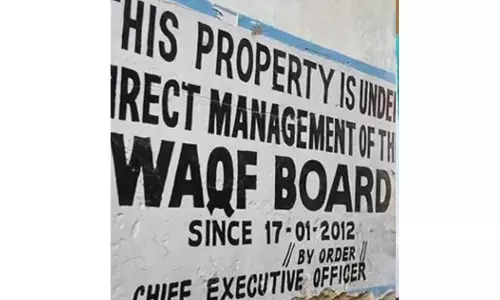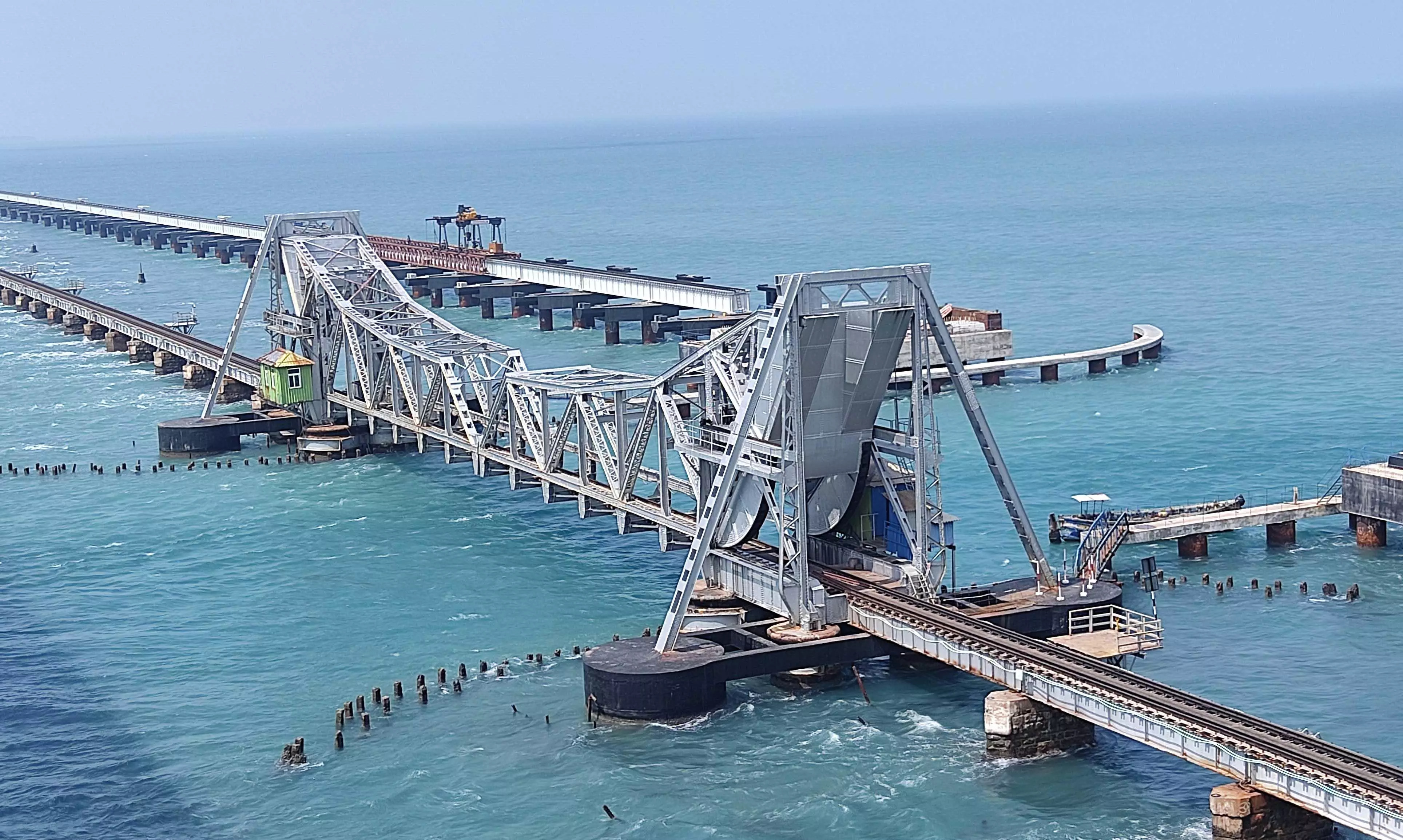
The abundance of offshore wind energy; challenges too
text_fieldsThe world needs green energy to exist sustainably. In order to generate renewable energy, various government authorities must ensure that the projects have no or relatively low environmental impacts. Since India is a developing country, experts suggest that the decision to establish offshore wind turbine should be accurately assessed and practical solutions adopted.
Despite the importance of renewable energy to the world, the country is facing numerous obstacles on the path to achieving this goal.
Industry experts say major hurdles are the huge investment requirement, viability gap funding, inefficient technology, and inexperience in offshore wind energy.
In Tamil Nadu, an offshore wind turbine project is proposed for the Gulf of Mannar, a biosphere reserve. Another hurdle has arisen as conservationists, marine scientists, and environmental activists are opposed to the project because it would threaten the ecology of the proposed location.
Pamban railway and road bridge
Thamilrasi (65), a fisherwoman in Dhanushkodi village, was drying fish when I arrived at noon. She leads a group of women fishers from three villages. She lives with her husband Umayavel (70) in a small hut made from four sticks and braided palm leaves and no electricity. Umayavel and his ancestors have lived in this village for generations but the threat of displacement is now looming due to climate change, coastal regulatory zone restrictions, and some government projects.
One particularly prestigious project proposes to install 35 GW-capacity offshore wind turbine in the Gulf of Mannar area, where Dhanushkodi is located.
The National Institute of Wind Energy reported in 2021 that 3,000-5,000 wind turbine might be installed at Dhanushkodi sea.
But it is not without tradeoffs. So now they are afraid of loss of marine biodiversity and loss of occupation too.
"We are worried that offshore wind projects will lead to job losses. None of the government schemes has helped us yet. In the past, we (fishermen) have always lost,” said Thamilrasi.
Demarcated offshore wind energy zones at Tamil Nadu
India’s push for renewable energy – on land and offshore
The country has set a target of producing 175GW of renewable energy by the end of 2022.
In Parliament, India’s New & Renewable Energy Minister R. K. Singh said that a total of 172.72 GW capacity from non-fossil fuel-based energy resources (renewable energy, large hydro and nuclear) has been installed in the country as of 31 October 2022. This comprises 42.26% of the total installed generation capacity.
With a population of 1.4 billion (and counting), India’s energy demand is expected to grow by 3% annually until 2040. There may be a huge power shortage in the country if this continues. However, India is the third-largest carbon emitter in the world. Fossil fuels, particularly coal, dominate installed generation capacity at present. The country must increase its electricity supply without compromising its climate change action plans.
In line with the Prime Minister’s announcement at COP26, the MNRE is working towards achieving 500 GW of installed electricity capacity from non-fossil sources by 2030. India is expected to meet 50 per cent of its energy requirements from renewable energy by 2030; by 2070, India will achieve the target of Net Zero.
Fishers of dhanushkodi area
Taking advantage of the wind energy potential of the Indian coast is one of the sustainable ways to meet the growing electricity demand. India is a country surrounded by water thanks to its approximately 7,600km long coastline. This is equivalent to 2.3 million square kilometres of exclusive economic zones. According to the World Bank, India's Exclusive Economic Zone has 195GW of technological offshore wind potential.
At the same time, the potential for land-based renewable energy projects is diminishing due to the lack of land availability and the high cost of land. Land acquisition in wind energy-rich areas is particularly challenging. As per the union ministry, the absence of any obstruction in the sea offers a much better quality of wind and conversion to electrical energy. Offshore wind turbines are also much larger in size (in the range of 8 to 14 MW per turbine) compared to 2-3 MW of an onshore wind turbine.
According to the Ministry for New and Renewable Energy, there are seven states that can produce 95% of India's offshore wind power, led by Gujarat (36GW) and Tamil Nadu (35GW), already a leader in wind power in India, without any active offshore wind projects.
Vulnerable ecosystem and community livelihoods at stake
The Gulf of Mannar region, so favourable for offshore wind, is home to an extremely important marine habitat.
It boasts the first Marine Biosphere in South and South-East Asia (designation date: 2001), spanning 10,500 square kilometres with a core area of 560 square kilometres. As a result of the 1972 Wildlife Protection Act, it is protected within a radius of 25 km.
More than 4,200 species of plants and animals live within the boundaries of the Gulf of Mannar, India's biologically richest marine region. The reserve is home to more than 290 species of birds. Its 11 species of mangroves, which serve as fish nurseries, are crucial to the ecology of the reserve.
Because of its unique geographical position, corals and sensitive fauna thrive on the aerated sandy seafloor in this clear, transparent water. Among the four major coral reef areas in the country, the Gulf of Mannar is the most protected.
Umayavel and Thamilarasi
According to Tamil Nadu State Planning Commission 2017, Kanyakumari is one of the world's 20 wadge banks. This region is a rich source of marine biological diversity. The 'Wadge Bank' area south of Cape Comorin is about 4000 square miles, closest to Zones E and G (see map).
In September this year, Palk Bay in the Gulf of Mannar was notified as India's first dugong conservation reserve (see map). The IUCN Red List lists the dugong, the largest herbivorous marine mammal in the world, as ' threatened with extinction’.
Due to its unique contributions to the maintenance of critical ecosystems, the dugong is also called an "ecological engineer", whose habitat will abut Zones A, C and F.
Anand Pattankatti, an executive member of the National Fish Workers Forum, said, "The aquatic ecosystem is the treasure trove that helps India earn money from fishing [beyond protected areas]. Tamil Nadu's yields are estimated to be 5.62 lakh tonnes (7,908 crores in 2021), and Ramanathapuram alone contributes 34% to the state's total landings. He believes all these will be destroyed once the offshore wind projects are installed.
Portraits of Corals of gulf of Mannar area at Krusadai island
In addition, ‘’Gulf of Mannar falls under ‘Wetlands of International Importance’, and there are different factors to consider for its management and conservation, says Nischal Devkota, Junior Professional – Technical Support (Asia/Oceania), Secretariat of the Convention on Wetlands, Switzerland.
According to the Ramsar Convention, if unpreventable wetland loss or deterioration does occur, then mitigation of the loss is expected, with compensation measures as a last-resort option where the change is irreversible.
As of now, a feasibility study carried out in 2018 admitted that the occurrence of migrating birds and marine mammals in the proposed offshore wind farm zones could have significant implications on the construction schedule and the installation methodology, e.g. pilings with noise mitigation measures could be required. The erection of met masts and site investigations may also require separate EIAs (Environmental Impact Assessments).
In the feasibility report, it was also stated that studies had found no evidence that turbine noise could disturb marine mammals, though experts disagree. The Journal of Acoustical Society of America reported that Frank Thomsen, of DHI, said offshore wind farms could disrupt marine mammal behaviour.
A recent report by the Centre of Excellence identifies Offshore Zone F of Tamil Nadu as an Important Marine Mammal Area (IMMA). It is, therefore, necessary to conduct a more detailed analysis and ensure a rigorous permitting process to ensure that environmental impact is minimized.
Concerns about the project’s impact on marine ecosystems and livelihoods could impede this ambitious project. A nationwide backlash could well be expected over the Dhanushkodi project, as coastal communities have historically been excluded from development and infrastructure planning processes that impact them.
Marine research centre at Krusadai island
Dhanushkodi is home to fishing communities that have lived and worked there for generations.
They depend heavily on the sea and seafood for their livelihoods. The sea is not under the control of coastal people, despite the fact that many tribal people argue that forest land should be given to them. As a result, when the governments implement their coastal construction projects, these people are forced to leave their work and homes. Their indigenous knowledge tells them that installing offshore wind turbine would be disastrous to biodiversity in the region.
In addition, when wind turbines are installed, large cables are needed to transfer energy from the sea to the land. Parvathy, a resident of Dhanushkodi fears that fishing boats will be banned as a result.
Fishermen who have some idea about what will happen have already spoken out against the project. Others in the Marakkar community remain unaware of the proposed project, and its implications.
“A lack of awareness in local communities, the lack of offshore wind-ready ports, and the lack of a local supply chain are among the challenges ahead,” said Vijay Kutty, a project manager with experience in offshore wind energy, based in the UK.
"The solution is to engage with communities early, through education, re-training, compensatory measures and alternative opportunities, if necessary etc.,'' said Vijay Kutty.
Funding gap
Just as environmental concerns might stymie progress on this front, the challenge of bridging funding gaps also remains.
''We need to overcome some of the significant challenges of port infrastructure and high initial investment ''said Kajol, Senior Manager- Industry Decarbonisation Energy Program, WRI (World Resources Institute) India.
The cost of connection, foundation, operation, and maintenance has proved to be lower for nearshore wind plants. Due to its long coastline, developed ports, and wind manufacturing base near the coast, Tamil Nadu can drive down the cost of nearshore installations, but it is still significant.
As the cumulative installed capacity of offshore wind projects increases, the cost of offshore wind projects gradually decreases. According to the global offshore wind energy scenario, the Levelized Cost of Energy (LCoE) will be in the range of Rs. 6.5-10 per unit initially, as opposed to Rs 2.8-2.9 per unit for onshore wind.
In August 2022, the Parliamentary Standing Committee on Energy recommended a total Viability Gap Funding (VGF) of Rs. 14,212 crores for the establishment of 3 GW of offshore wind energy projects (1.0 GW off the coast of Gujarat and 2.0 GW off the coast of Tamil Nadu). Separate transmission and evacuation infrastructure with an estimated cost of Rs. 13,500 crores will also be required to enable power evacuation through these offshore wind power projects. Power evacuation is a critical function that allows generated power to be immediately evacuated from the Wind Power Plant to the grid for distribution.
In an effort to accelerate the construction of offshore wind farms in India, the Government of India has agreed to collaborate with Denmark. Danish participation is expected to result in an investment of $5-10 billion in the renewable sector. In addition, India and Denmark established a knowledge hub called the Centre of Excellence for Offshore Wind & Renewable Energy (COE).
By November, the Ministry of New and Renewable Energy had initiated the tender process for the auction of the seabed constructions at four locations. They invited bids for 4GW of energy from these locations. These are the proposed offshore wind sub-blocks B1, B2, B3, B4, and G1 in the Gulf of Mannar. The actual MW capacity to be installed by the developer in the allocated block will be determined at a later stage after a detailed survey is carried out by the developer.
Seabed leases will be awarded to selected bidders subject to conditions following a global tender. Last month, the draft tender was invited for suggestions. In the second stage, the bidder offering the highest lease fee per square kilometre of seabed area will win the lease rights.
Over the next eight years, the country plans to auction off areas offshore Tamil Nadu and Gujarat each year until 2030.
For all offshore wind capacities that will be bid out until 2030, evacuation and transmission from offshore pooling substations (PSS) to onshore transmission will be provided free of charge.
The evacuation of power from the offshore pooling delivery point to the onshore meeting point will be the responsibility of the central transmission of utility for all offshore wind project development models.
It is clear that a regional energy supply chain, logistics and port infrastructure will be essential to maximise India's offshore wind potential.
To start the offshore wind industry in the country, the government is preparing a production-linked incentive (PLI) scheme. Through that scheme, the government will provide subsidies to companies that manufacture turbines.
Paradi villegers
''Developing projects in sea depths of 20-40 meters and 5-10km from the shore will be challenging'' -says Vibhuti Garg, Director, South Asia at Institute for Energy Economics and Financial Analysis (IEEFA), acknowledging that a proper marine assessment of sites needs to be done and evacuation infrastructure needs to be developed.
“The costs of offshore are 3-4 times higher than the onshore wind. However, the gains in terms of higher capacity utilisation factor (CUF) are immense and will also ease pressure on land. This can be addressed through providing fees in tariff or viability gap fund (VGF) in the initial years till the time the costs go down and it becomes commercially viable on its own,” she adds.
The Standing Committee on Energy observes that with increasing economies of scale, more competitive supply chains, and further technological advancements, the tariff can be reduced significantly for subsequent projects.
This story was produced with support from Internews’ Earth Journalism Network.






















